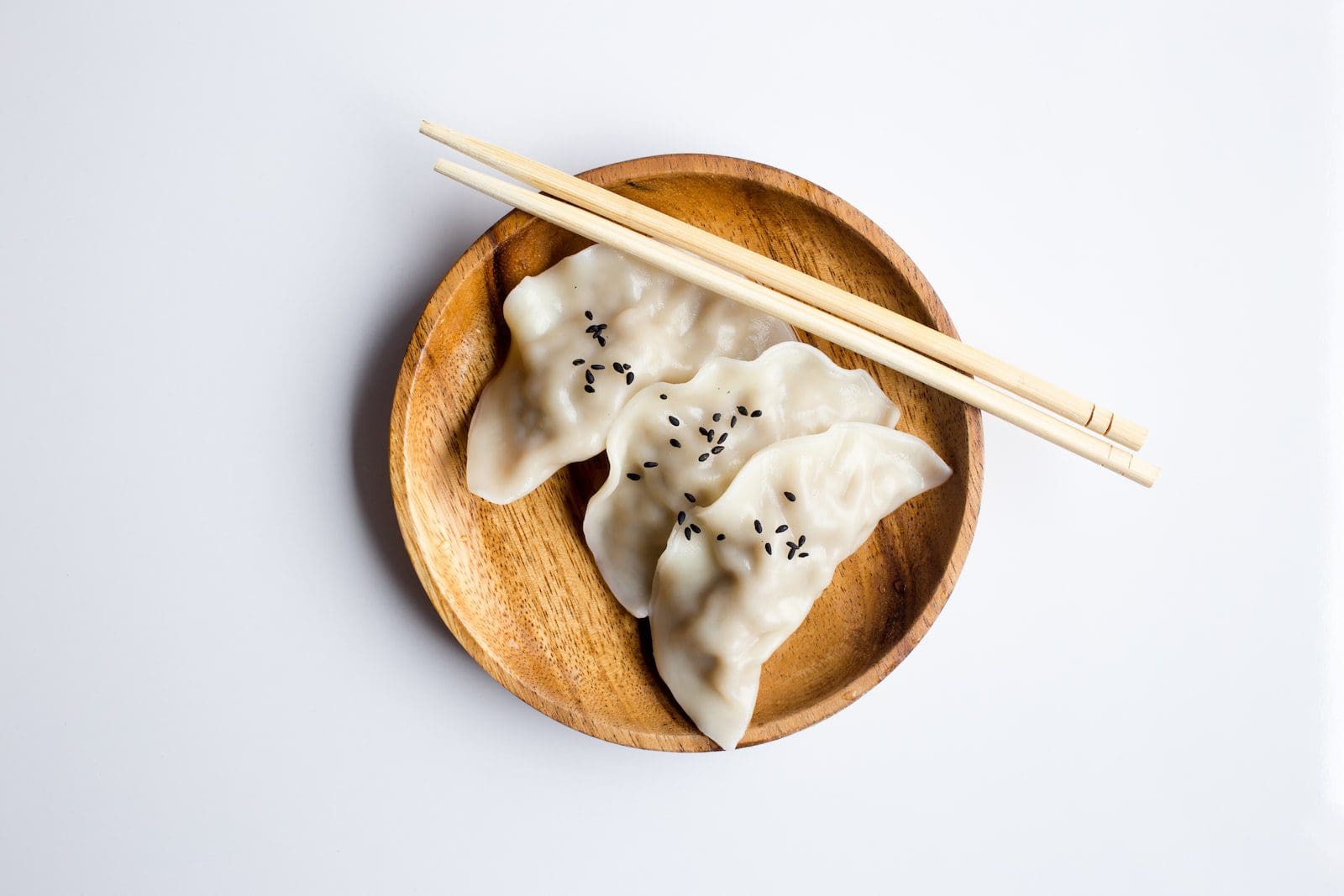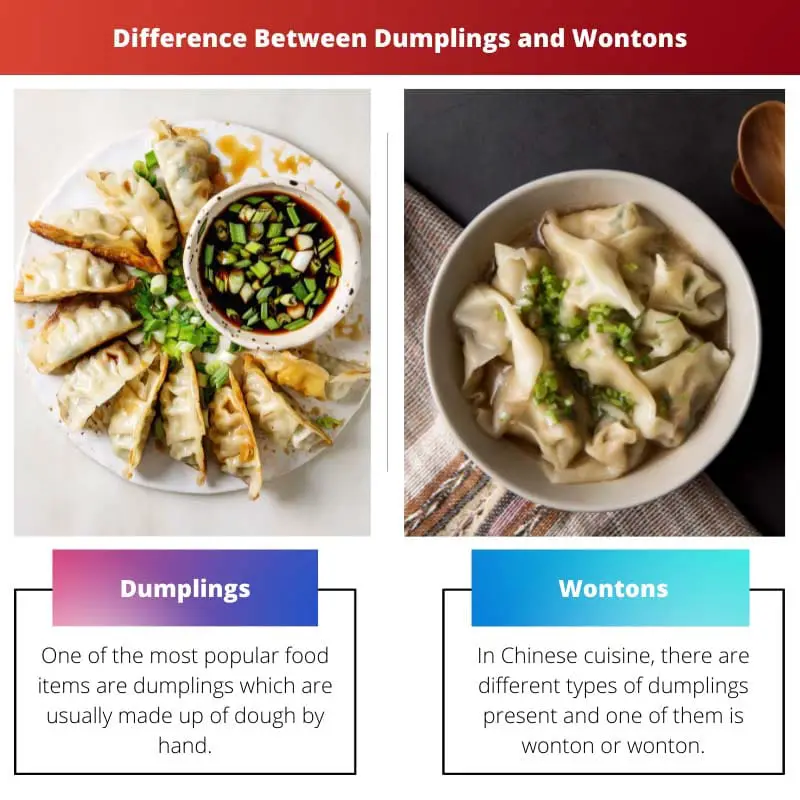Chinese food and cuisine are among the most irresistible food items globally. Their delicious food has taken over the world and becomes very popular.
The two most famous food items are dumplings and wontons.
Key Takeaways
- Dumplings are a broad category of cooked dough dishes that can be filled or unfilled in various culinary traditions worldwide.
- Wontons are a specific type of Chinese dumpling made with thin, delicate wrappers and filled with minced meat or seafood.
- Wontons are a type of dumpling, but dumplings encompass a wide variety of dough-based dishes from different cultures, whereas wontons specifically refer to a Chinese variety.
Dumplings vs Wontons
Dumplings are made from a thin sheet of dough filled with meat, vegetables, or a combination of both and can be boiled, steamed, or fried. Wontons are Chinese dumplings made by filling a small square of dough with ground meat and spices, folding it into a triangle or rectangle shape, and pinching the edges together.

On the one hand, Dumplings consist of a wide range of food made up of small dough balls with some fillings in it or not.
On the other hand, one form of dumpling is Wontons which are filled thinner and have more seasoned filling or ingredients than a generic dumpling.
Comparison Table
| Parameter of Comparison | Dumplings | Wontons |
|---|---|---|
| Wrapper | The wrapper of dumplings is thicker | The wrapper of wontons is thinner than dumplings |
| Types | There are many different types of dumplings in Chinese cuisine. | Wonton is one type of dumpling in Chinese cuisine. |
| filling | Most dumplings across the world can be eaten with or without a filling. | Wontons are always filled with meats, pork or vegetables |
| Dipping sauce | Dumplings go with a dipping sauce; their filling is lightly seasoned. | Wontons don’t go with a dipping sauce as their filling is completely seasoned. |
| Shape | The dumpling mostly comes in a round shape | Wonton will take on a triangular shape, rectangle and even square |
What is Dumplings?
One of the most popular food items is dumplings, made up of dough (wheat flour, potato flour, etc.) by hand. They can be steamed, baked, fried, boiled or any method where they can be mixed.
The first ever dumpling came around 1800 years ago in China by a healer named Zhang. He made them with the help of dough balls along with lamb, chilli and herbs as fillings.
He gave these dumplings to the people who were sick, and they healed quickly. Therefore, it was used as a medicinal meal.
In today’s time, dumplings are made and eaten during the new year as a representation of happiness in the family.
Though different countries have their preferences, they are round and have fillings like meat or vegetables. In most cases, dumplings are very light in taste but can also be eaten with soups, sauces and gravies.
Around the world, Dumplings are found in various cuisines. Alterations in terms of filling ingredients or dough are made by People across the globe depending on their liking and preference.
Confusion among dumplings occurs due to differences in wrappers and how the wrapping is done. But no matter what, food items with different names from different countries belong; the general name dumpling is the main base.
Around the world, dumplings come in many dishes, such as ravioli, baked dumplings, gyoza, samosa, Jiao Zi and many more.
| # | Preview | Product | |
|---|---|---|---|
| 1 |

| McLib's Southern Dumplings, 8-ounce Box | Check Price on Amazon |
| 2 |

| Pfanni Potatoe Dumplings (Kartoffel Knoedel) 190g | Check Price on Amazon |

What is Wontons?
In Chinese cuisine, different types of dumplings are present, and one of them is wonton or wonton. In Northern China, Wonton is a traditional meal initially referred to as the meat bun.
There are various stories behind the origin of Wonton in China. Some call it a sealed meat bun with no holes, especially in northern China, whereas Another name they gave to it was humid due to the story of two leaders, Hun and dun.
It is made with wheat flour dough, eggs, salt and water and contains meat or pork cut into smaller pieces. Seafood like shrimp is also used sometimes as filling.
The wrapper is excellent and smooth across one’s palm. The fresh filling is placed inside, and the shape is given to this dumpling- wonton.
Across the globe, they do not go with a dipping sauce in various cuisines as their filling is completely seasoned. But when wontons are served boiled, they are served with soups.
Wontons can be deep-fried, boiled and steamed.
In most cuisines across the globe, Wontons come triangular. But it can take any shape, such as triangular, rectangle or even square, depending on the person making these dough balls.
| # | Preview | Product | |
|---|---|---|---|
| 1 |

| 365 by Whole Foods Market, Organic Wonton Strips, 3.5 Ounce | Check Price on Amazon |
| 2 |

| Quoc Viet Foods - Wonton Soup Base 10oz Cot Sup Hoanh Thanh Brand | Check Price on Amazon |

Main Differences Between Dumplings and Wontons
- In terms of wrappers, dumplings are way thicker than Wonton.
- There are many different types of dumplings in Chinese cuisine, whereas wonton is one type of dumpling in Chinese cuisine.
- Most dumplings worldwide can be eaten with or without a filling, whereas Wontons are filled with meats, pork or vegetables.
- Dumplings go with a dipping sauce as their filling is lightly seasoned, whereas wontons don’t go with a dipping sauce as their filling is wholly seasoned.
- The dumpling mostly comes round, whereas wonton will take on a triangular shape, rectangle and even square.


The wealth of knowledge shared about the origins and characteristics of dumplings and wontons is truly enlightening. It’s remarkable how these culinary treasures have traversed geographical boundaries and found a place in diverse cuisines worldwide.
Absolutely, Xevans. The global ubiquity of dumplings and wontons speaks volumes about the allure and adaptability of Chinese cuisine, transcending cultural borders and uniting food enthusiasts across the globe.
The intricate details provided shed light on the remarkable journey of dumplings and wontons, showcasing the universality and timelessness of these culinary delights.
The in-depth exploration of the nuances between dumplings and wontons enhances our understanding of their distinctive characteristics. The amalgamation of history, folklore, and culinary artistry enriches our culinary journey into Chinese cuisine.
The diverse array of dumplings across different cultures underscores the universal appeal of these delectable delights. The global manifestations of dumplings, from gyoza to samosas, echo the transcultural resonance of Chinese culinary artistry.
Indeed, Khunt. The kaleidoscopic variation of dumplings worldwide is a testament to the cross-pollination of culinary traditions, underscoring the intricate interplay of cultural exchange and gastronomic innovation.
I’ve always been a huge fan of dumplings and wontons. It’s interesting to see the specific differences outlined in the comparison table. The historical origins of these delectable food items are equally intriguing. Thanks for sharing!
The detailed descriptions of dumplings and wontons are informative and comprehensive. The historical narratives behind these culinary delights add an enriching layer to their appeal and significance in Chinese culture.
Absolutely, Isabelle44. Understanding the cultural, historical, and culinary context of these dishes enhances our appreciation for the artistry of Chinese cuisine.
I couldn’t agree more. Unveiling the stories and traditions behind dumplings and wontons truly deepens our connection to the rich tapestry of Chinese culinary heritage.
Although the comparison between dumplings and wontons is well-detailed, the traditional aspect of Chinese cuisine and the impact of these dishes on global food culture cannot be overstated.
I see your point, Carter Nick. Chinese cuisine has undoubtedly made a significant impression on global gastronomy, and these iconic dishes continue to be cherished and celebrated.
While the factual differences between dumplings and wontons are evident, the cultural and culinary influence of Chinese cuisine through these dishes deserves more recognition and appreciation.
The encapsulation of culinary history and cultural significance within the context of dumplings and wontons paints a vibrant tapestry of the enduring legacy of Chinese gastronomy. A captivating portrayal of timeless culinary treasures.
Chinese cuisine is truly a world wonder! The deep history and tradition behind dumplings and wontons make them incredibly popular and an irresistible food item around the world. The comparison table provides a clear distinction between the two, and the origin stories are fascinating!
I completely agree with you, Asmith. The rich history and cultural significance of both dumplings and wontons are truly captivating. Their popularity on a global scale is a testament to the allure of Chinese cuisine.
The shared insights about the origins and evolution of wontons provide valuable historical context and appreciation for this quintessential Chinese delicacy. A delightful foray into the legacy of Chinese culinary heritage.
Absolutely, Zrichards. The journey of wontons across historical narratives and contemporary culinary landscapes echoes the resilience and reverence for Chinese culinary traditions, fostering an enduring legacy in the realm of global gastronomy.
The narrative of Zhang’s healing dumplings and their evolution into a symbol of joy during celebratory occasions offers a poignant glimpse into the cultural significance of these iconic Chinese dishes. Truly fascinating!
I share your sentiment, Julie51. The interconnectedness of tradition, symbolism, and gastronomy within Chinese cuisine is beautifully encapsulated in the story of dumplings, adding depth to their culinary legacy.